Search Results for Tag: Arctic circle
Exploring the North – Looking South: On a bottle of wine and into the ocean
But the Arctic isn’t the only place that’s important for the planet. Just on the other side of the planet, there’s another precious region: Antarctica. Why? Antarctic glaciologist Kenichi Matusuoka from the Norwegian Polar Institute explains this with the help of a bottle of wine.
Imagine holding a bottle of wine. The wine inside the bottle is very precious (and expensive), compared to the rest of the bottle – the glass body and the bottle cork. The wine corresponds to the ice in Antarctica: It is important for the planet as its melting could lead to a rise of 45 meters in sea levels.
Now imagine you turn the bottle upside down – the previously unimportant cork now becomes quite important as otherwise the precious wine would pour out. You can well imagine that the cork is now crucial, whether or not it’s a crumbly old cork that is only plugged loosely in the bottle neck, if you want to find out whether the wine will pour out or not.
That is why scientists focus on investigating the properties and melting behaviour of ice shelves, which is what the cork corresponds to. To be correct: Antarctica does not only have one “cork” like a bottle has, but several – those on top behave differently. But the overall research question is, whether climate change weakens the corks/iceshelves so intensely that they cannot withstand the pressure of the wine/Antarctic ice and finally might let it pass.

Antarctica from space: Blue-pinkish coloured are the ice shelf regions, where ice flows quicker than on land-grounded ice (Photo credit: NASA/JPL-Caltech/UCI)
During my travels in the Arctic region, I actually met a researcher who worked on the dynamics of Antarctica’s ice shelves. Tore Hattermann investigated the melting of a certain ice shelf underside. To get back to the cork analogy, you can imagine that it is rather crucial what size the cork has. If it’s too slim, the wine behind can easily push it away.
In West Antarctica, for example, a change in ocean circulation leads to warmer water below the ice shelves that starts to melt, contributing to more than two thirds of Antarctica’s mass loss. Now, computer simulations predicting that those circulations also transport warm water below the Fimbul ice shelf suggest additional melting. The Fimbul ice shelf is located not in the West, but in the East and has similar geographic conditions as the melting Western shelves have.

Tore Hattermann working on Antarctic ground – attentively observed by a penguin (Photo: Johan Hustadnes)
So, together with other scientists, Tore went on an Antarctica expedition to see whether the simulations are correct and if they could really find warmer water underneath the Fimbul ice shelf. Using boiling water, they drilled holes through 400 meters of ice and passed oceanographic instruments into the ocean below. Over two years those instruments measured water properties: its flow velocity, temperature, salinity and oxygen content. After analyzing the data collection, Tore could prove that the computer simulation was wrong: There was not that much warm water circulating under the Fimbul ice shelf, therefore it wasn’t melting at the extent predicted.
For most people this might seem a disappointment, but for scientists this is rather routine: proving models (wrong). In order to improve or adjust the models in the next step, therefore they depict reality better and predict Antarctic ice shelf melting correctly.

I did not want to deny you this drawing, as sometimes pictures say more than words. That’s this issue explained in a(n abstract) picture. Savvy?
Watch out for the next issue to find out, what the expedition to Antarctica was like for Tore.
Exploring the North – Further North
Arriving in Tromso, Norway, we are now located just at the Arctic’s doorstep. It is a quiet strange feeling, when you suddenly stand at the edge of something, that is normally so incredibly far away. If it’s far away from you as well and you derive from that that you don’t have to care – hang on. You actually should, as the Arctic often is referred to as earth’s air conditioner. And on hot summer days without (working) air conditioning, you feel perfectly well what it is good for.
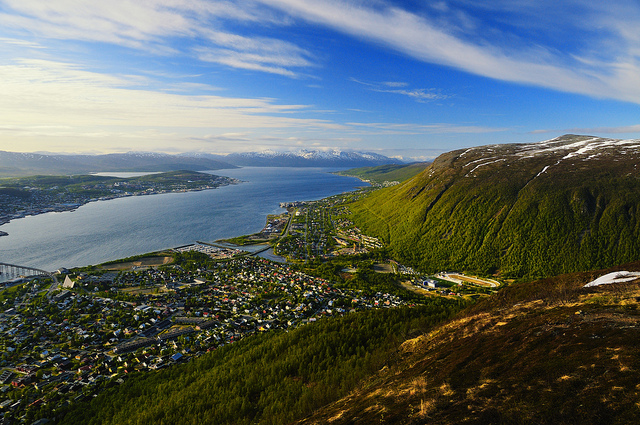
Thought you might have seen enough snow, so I found this Tromso view of June 2010 for you (Photo: CC-BY-NC-SA-2.0: Nietnagel)
If you look at such pictures of the Arctic region it does not at all like an air conditioning. I was actually suprised that it can be that green in the Arctic region, as I always associate of snow and ice with Artic. What about you?
But this ice is only there in winter time – that’s when it fulfils it’s cooling job, by reflecting 80 percent of sunlight back to space which then cannot heat up the ocean or earth anymore. But from March on, ice starts melting due to increasing temperatures. The decreasing sea ice cover uncovers the dark oceans that absorbs the sunlight instead of reflecting it – the cooling air conditioning turns into a heating facility.
So far, the Arctic yet hasn’t been completely ice-free during the warm summer period. But you might remember scientists worrying last summerabout the small area that is left ice covered: The larger the ice free part, the more heat is absorbed by the ocean underneath – in turn, even more ice melts and a vicious circle starts.
Not on the edge of the Arctic, but on the edge of Arctic research, you find scientists working on how this influences the Arctic environment. Sometimes this influence can even be positive: Researchers recently found that microbes in the soil can fix more carbon in a warmer climate.
But yet, researchers cannot tell how Arctic ice cover will evolve, but they work for example on better models to predict what is going to happen. That is especially important, as many earth systems are connected: A warming Arctic sea also affects ocean currents for example, that – connected to each other – span over the whole planet. In turn, oceans take up less CO2 for example, and in consequence more of this greenhouse gas in the air, warms up the whole planet.
Exploring the North – Lighting up the dark
Being out in the nowhere around Abisko also has a major advantage: due to the very small light pollution, you might get the chance to see what the polar region is famous for: the Northern lights.
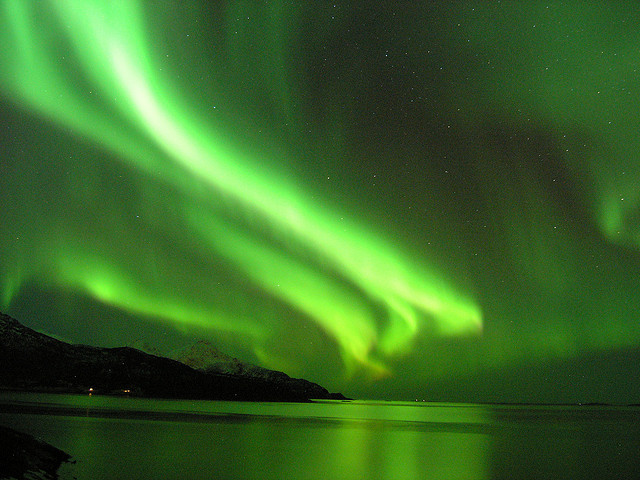
When solar particles hit the earth’s atmosphere, sky starts to shine (Photo credit: CC BY SA 2.0: Gunnar Hildonen)
In one sentence: Northern lights occur when cosmic radiation meets the molecules of our atmosphere. In a few more sentences: Such radiation normally comes from the sun, being the closest active star around. When this so called solar wind hits the earth’s magnetic field with more than 700 kilometers per second (!) it’s particles are torn apart into charged particles which spans electric tension over the earth. This tension is discharged as the particles run along the earth’s magnetic field towards the poles, where this field is the strongest (This is also the reason why you can’t see the lights all over the world: the further you move from the poles, the lower is the chance to actually see the lights).
In 150km heigth those charged particles hit the earth’s atmosphere, and thereby pass some part of their energy onto the molecules of earth’s atmosphere, which – finally – stimulate them to glow. Which colour the lights have differs from height and the atmosphere’s composition.
There also might be a yte loose connection to climate change: There is a theory that this beautiful natural phenomenon helps to cool the earth. Due to the ionization of the air, also clouds might be formed and in consequence insulate the earth from warming rays of sunlight.
Exploring the North – Visible signs of climate change
Almost in the middle of nowhere, where just a few houses stand between trees around the lake, there is kind of a research nest. Scientists from different countries live and work together in Abisko, Sweden, to investigate the impact of climate change in the Arctic region.
That is especially feasible, as the research station is located North of the polar circle. The Arctic region is far more sensitive to climate change than others: While globel mean temperature yet rose by 0.8 degrees celsius, the Arctic already warmed by more than one degree on average.
“If you came here 40 or 50 years ago, you would see that the treeline has risen since then”, says plant ecologist Ann Milbau.
Also the composition of species growing here has changed: mosses do worse, while more grasses growing on the vast ground. But in the last years, researchers suddenly walked on a green moving carpet – made of caterpillars. Temperature in the previous winter did not fall below -35°C, a threshold above which all caterpillar eggs survive. The eclosed moths ate away all leaves from the trees. “There was nothin green here in summer”, Milbau says, “But yet we don’t know, whether this was just an exception or really a sign of climate change.”
Which visible signs of climate change can you see in your environment?
Exploring the North – treasures under the ice cover
Our Global Ideas reporter Gianna Grün recently made a trip to the Arctic Circle and has written about tracking reindeer, an encounter with Sami herdsmen and sleeping in a hotel made entirely of ice. Check out her latest article from the freezing North.
What looks like a lovely winter wonderland landscape is in reality a perfect source for building material. No, I’m not talking about the few trees on the horizon – the resource slumbers below the snow cover! Hidden from the eye, the Torne river flows below the snow. Well, at least the part that’s not frozen. But the more interesting part is the ice cover. In March, i’s thick enough for ice block harvesting to begin.
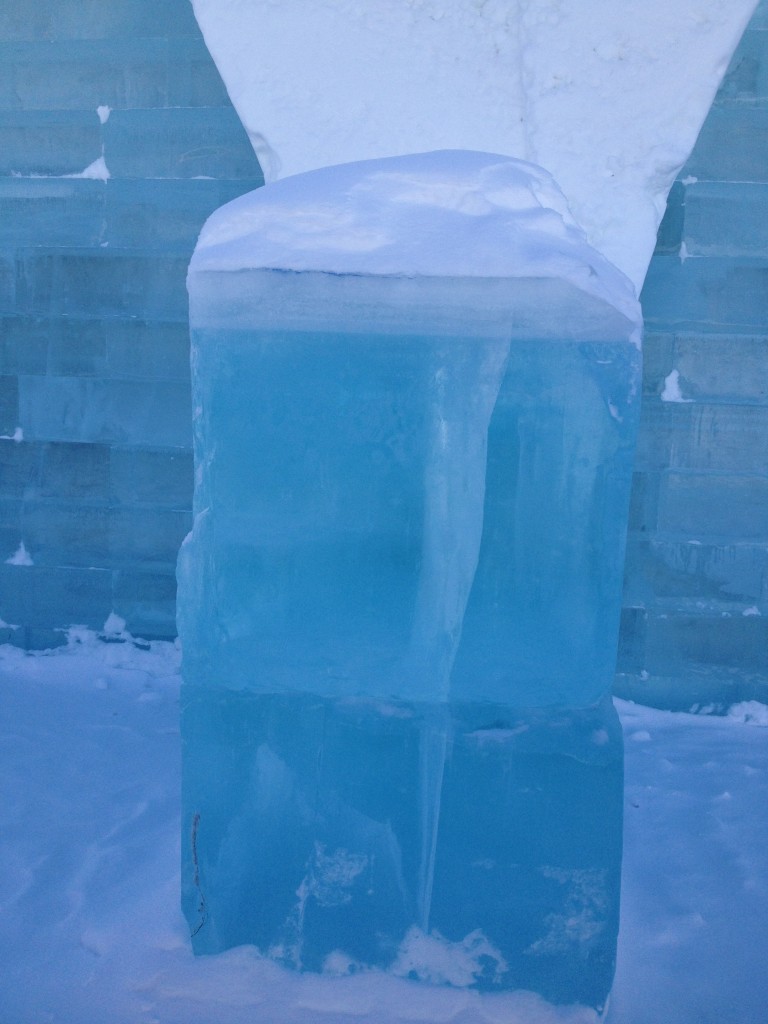
Ice blocks of such a size are hacked out of the Torne river in March and April each year. One block weighs 1.8 tons.
Some 2,500 of such 1.8 ton blocks are cut out in March and April to build a new hotel made of ice near Kiruna, Sweden. When spring arrives in other parts of the world, the ice is in perfect condition for building a new hotel from scratch next winter. The ice is at least 80 centimeters deep and crystal clear due to the high water quality of the Torne river and its perfect velocity and depth. Upstream, the water flows too fast and stirs up sediment from the river floor. Downstream from here, the water is too still and lacking in oxygen so you get milky ice.
Though it is quite cold up here in the North, building doesn’t begin right after harvesting. While the old ice hotel is literally melting, the 5,000 tons of newly harvested ice are stored over the summer. From April until October, the storage hall is cooled to minus six degrees Celsius. That requires almost 240,000 kilowatts of energy, which comes from renewable sources. Between November and March, no cooling is required since the outside temperature is cold enough. Thanks to the massive blocks of ice and the isolation, the entire place stays cool enough.
When construction begins in winter, the ice hotel builders arm themselves with electric irons and smoothers. Well, not for cleaning their teeth or ensuring wrinkle-free shirts, but for the fine tuning. After chain saws, tractors, snow cannons, snow throwers, wheel burrows, spades and chisels have got the basics in place, the finer details, embellishments and sculptures are readied to give the whole space a cozier feel despite the cold.
It takes six to eight weeks to set up the whole hotel. Apart from ice, a special mixture of ice and snow called “snice” is used as a kind of mortar. In addition, some wooden structures are built in the ice to support the very high and steep arches and a few reindeer skins cover some surfaces.
Apart from offering visitors the unusual experience of sleeping in a room surrounded by ice, the hotel is also trying its hand not just at cutting its carbon output but actually becoming CO2-negative. So far, it’s reduced overall energy consumption by 20 percent. But in future, it aims to cut CO2 in its immediate surroundings by an amount that exceeds its overall energy consumption.
Do you know of similar projects that use building materials lying right at the doorstep, without harming the environment?




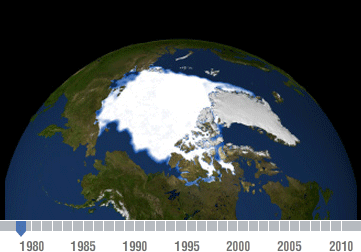
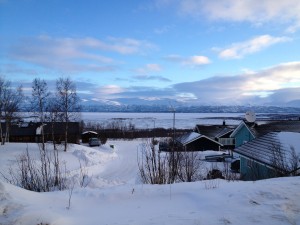
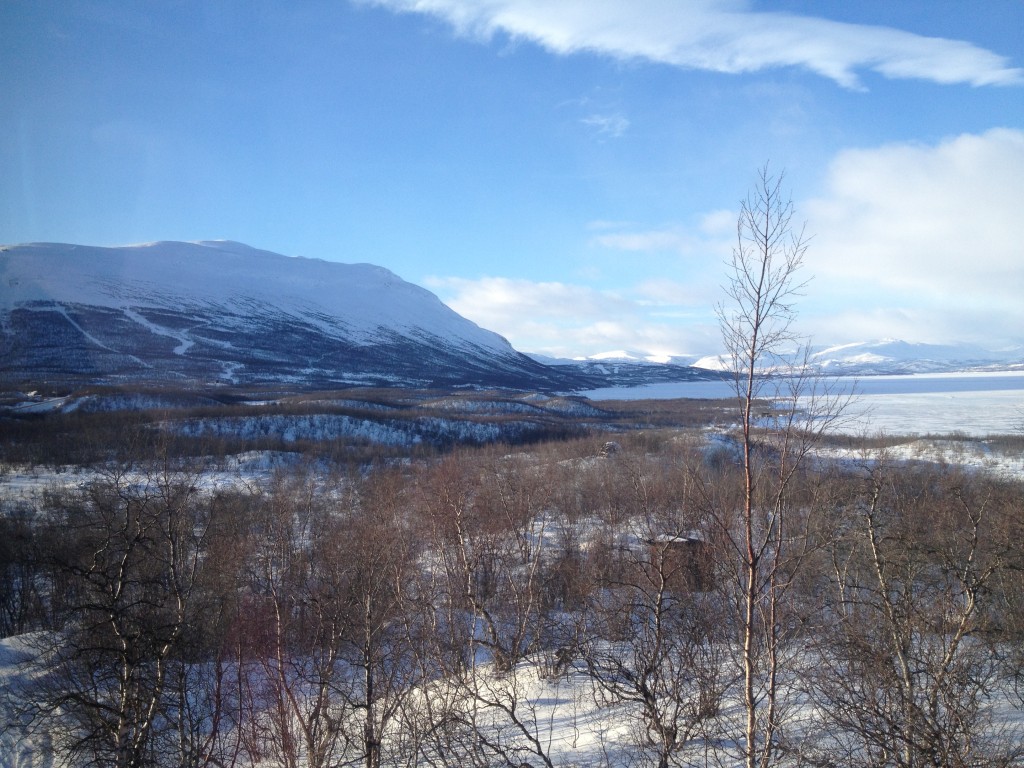

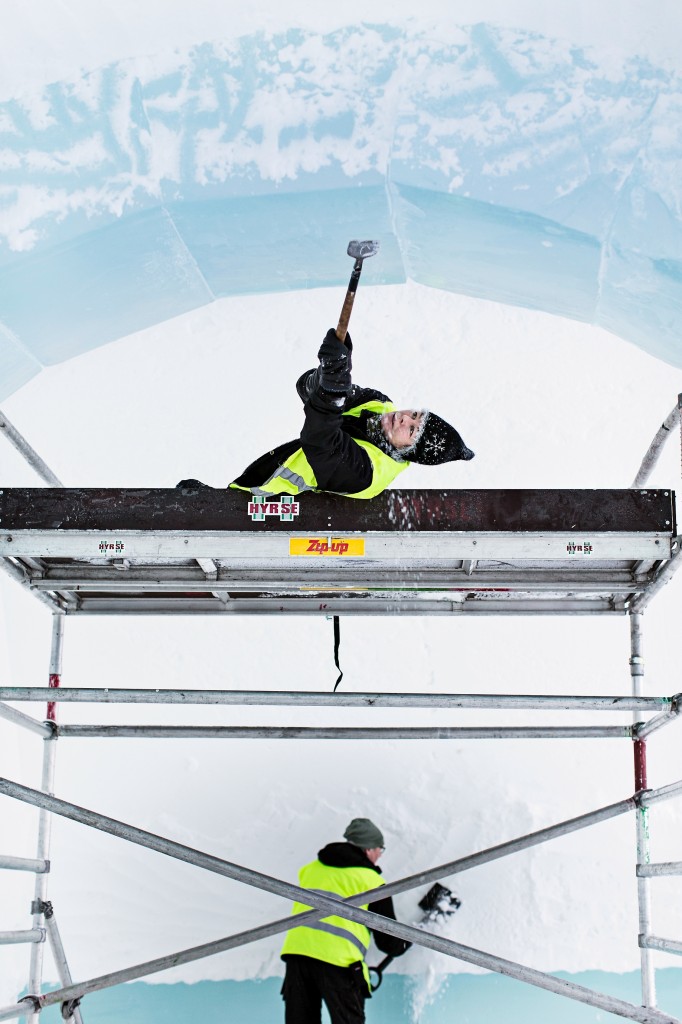

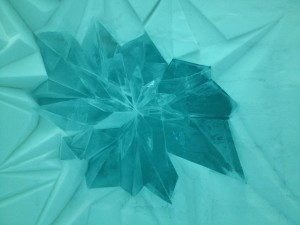
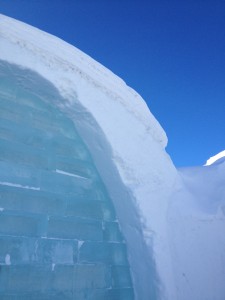




Feedback